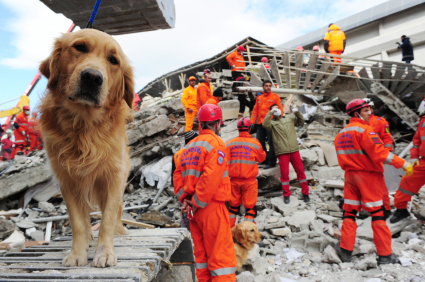Abstract:
Following a radiological terrorist incident, search and rescue (SAR) teams may be deployed to search for victims. While SAR personnel wear protective equipment such as coveralls, gloves, and respirators, only limited protective equipment is available for search dogs, and actually limits their ability to maneuver around. This reduced ability leads the SAR dogs to often wear no protective equipment while participating in a task, trading protection for efficiency. During a missions where they will operate in contaminated areas, this lack of protective equipment will expose them to radionuclides through a variety of pathways. Previously, little was known about the doses received by these dogs, and because of the uncertainty in the consequences for this exposure scenario, many SAR teams and handlers are concerned for the safety of their animals during such missions. Health physicists in the Nuclear Engineering Department at Texas A&M University in conjunction with the School of Veterinary Medicine will present a study that utilize the QUIC-PLUME atmospheric dispersion and HotSpot emergency response softwares . An RDD scenario was simulated with ground deposition, air concentration and resuspension data obtained and analyzed in order to produce an estimate for the doses received by these SAR dogs through multiple pathways using FRMAC methodology. Future work on the subject will also be discussed with the hope that these dose estimates can be used by event health and safety personnel to avoid acute effects and reduce the risk of long-term effects to SAR dogs.

Search and Rescue Dog (Photo credit: http://www.deerfieldvet.com/)
Associated Publications:
- C.M. Marianno, K.M. Cook, "The Use of PET-CT to Evaluate Internal and External Contamination on a Canine Exposed to a Contaminated Environment", 64th Annual Meeting of the Health Physics Society, Orlando, Florida, 7-11 July 2019.rn
- A. Hargraves, K. Cook, C. Marianno, and V. Sridhar, "Case Report: PET Imaging of Dog Exposed to Artificially Created Search and Rescue Set-up Contaminated with FDG", Open Journal of Clinical and Medical Case Reports, 5, 14 (2019).
- M. Chen, "Validation of a Dose Assessment Method to be Used in Loose Contamination Exercises", M.S. Thesis, Nuclear Engineering, Texas A&M University, College Station, TX (2019).
- K. Cook, "Analyzing Urban Search and Rescue (USAR) Dogs in a Radioactive Contaminated Environment", M.S. Thesis, Nuclear Engineering, Texas A&M University, College Station, TX (2019).
- J. Trevino, C. Marianno, "Calculation of Canine Dose Rate Conversion Factors for Photons and Electrons", Journal of Health Physics, 144, 1 (2018).
- J. Trevino, "Dosimetry for Search and Rescue Dogs in Contaminated Environments", Ph.D. Dissertation, Health Physics, Texas A&M University, College Station, TX (2016).
- J. Trevino, C. Marianno, J. Poston, and J. Ford, "Calculation of Scaled Dose Rate Conversion Factors for Search and Rescue Dogs", 61st Annual Meeting of the Health Physics Society (HPS), Spokane, Washington, 17-21 July 2016.
- J. Trevino and C.M. Marianno, "Dosimetry for Search and Rescue dogs in Contaminated Environments", 2016 South Texas Chapter of the Health Physics Society (STC-HPS) Student Presentation and Annual Business Meeting, Bryan, Texas, 16 April 2016.
- Trevino, J., Marianno, C., Poston Sr., J., Ford, J., Bissett, W. , "Post RDD-Scenario Dosimetry of Search and Rescue Dogs", Health Physics Society 60th Annual Meeting, Indianapolis, Indiana, 12-16 July 2015.
- C.M. Marianno, M. Smith, J. Trevino, and J. Erchinger, "A Radiation Contamination Exercise for Urban Search and Rescue Teams", 59th Annual Meeting Health Physics Society, Baltimore, Maryland, 13-17 July 2014.
- J.F. Trevino, C.M. Marianno, J. Poston, "Dose Reconstruction and Estimation to Search and Rescue Dogs Following an RDD Explosion", South Texas Chapter of the Health Physics Society Annual Meeting, College Station, Tx, March, 2014
- J. Trevino and C.M. Marianno, "Dose Estimation and Effects of Radioactive Particulate Inhalation in Search and Rescue Dogs"", 58th Annual Health Physics Society Meeting, Madison, Wisconsin, 10 July 2013.